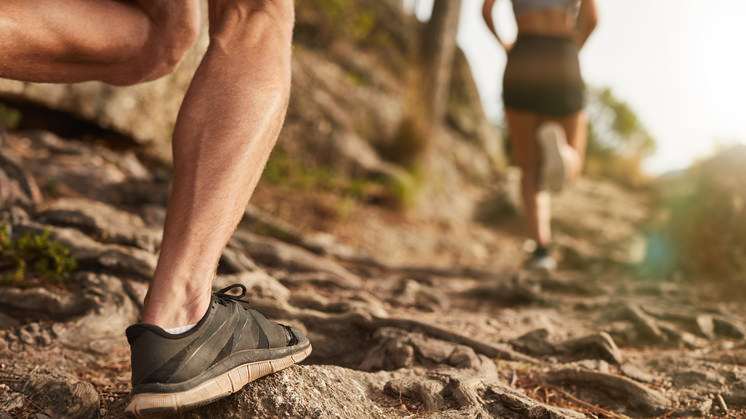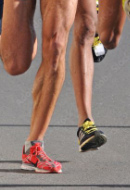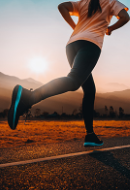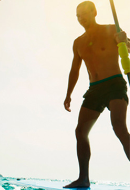Trail running
Off-road running: what you need to know
Trail running has many physical and mental benefits. Running in nature can be a great way to exercise, explore your surroundings and find peace in nature. Learn more about what trail running involves, how it differentiates from running and what its benefits are.

Forests, deserts or mountains. Any natural environment is ideal for trail running, a variant of athletics that moves away from tracks or urban areas. The aim is to cover the distance as quickly as possible. Although trail running may seem a simple activity, it is a very technical sport. The trail is presented as an obstacle course for runners, who have to negotiate uneven terrain, climb over rocks, avoid bodies of water and cross different types of surfaces.
Trail running has become increasingly popular in recent years, partly because it is a sport that does not require a large investment. It is also because it pushes runners to their physical limits, with high demands on leg strength, balance and endurance.
The beginnings of trail running date back to the origins of mankind. However, trail running, as a sporting discipline, is relatively modern and has evolved, with more women practising it over time and more competitions of different levels and demands.
Difference between trail running and running
Trail running and running are two similar forms of exercise. However, there are a few key differences between the two. First, trail running usually takes place on unpaved surfaces, such as dirt trails, while running is usually trained on paved roads or tracks. Trail runners must also be careful in order to avoid obstacles such as rocks, holes or tree roots.
Secondly, trail running involves running along hills and dealing with different elevation changes, whereas in running the dips/rises in the road are much lower. Therefore, runners must follow a demanding training plan to face the difficulties in running.
Finally, trail running requires more specific equipment than conventional athletics, with shoes suitable for rocky terrain and a hydration pack, for example.

Masters Athletics
Masters athletics is gaining ground.

Triathlon
Triathlon: how to exceed your own limits.

Running
Tips on how to start running.

Paddle Surf
Stand up paddle surfing: surfing for everyone.
Benefits of trail running
Trail running is considered a very complete and physically demanding discipline. Some of the most outstanding benefits of trail running it offers are:
![]() Improves our cardiorespiratory system
Improves our cardiorespiratory system
When we run, we increase our blood volume and get our heart pumping with less effort. In addition, the lungs begin to oxygenate more easily.
![]() Strengthens bones and muscles
Strengthens bones and muscles
With continuous practice on obstacle-filled terrain, bones become stronger and are even able to accumulate more calcium. In addition, many more muscle groups and joints are worked than in conventional athletics.
![]() Improves balance and coordination
Improves balance and coordination
Uneven terrain is responsible for gradually improving our balance and coordination. Trail running involves a continuous adaptation to different types of surfaces and elevation gains.
![]() Prevents cardiovascular diseases or risks
Prevents cardiovascular diseases or risks
The high level of physical demand when running off-road helps to control obesity, hypertension, diabetes and high cholesterol levels. It also strengthens the immune system.
![]() Reduces stress, anxiety and depression
Reduces stress, anxiety and depression
Athletics in general and trail running in particular produce an increase in the levels of noradrenaline, a substance relevant to the body's response to stress, and serotonin, which helps to improve depressive symptoms and reduce anxiety. In addition, running facilitates rest thanks to the secretion of endorphins.
![]() Connects us with nature
Connects us with nature
This type of sport promotes contact with nature – away from urban environments and stressful routines. Thanks to trail running, you can discover new places where you have never been before.
Trail running, get the right gear to safely enjoy the mountain
Sunglasses
Lightweight with a category 4 solar filter. They should also protect against lateral sunlight
Cap
Better with neck protection
High socks
They prevent pebbles, sand, twigs and other objects from entering your shoes
Collapsible trekking poles
They will help your balance, relieve some of the weight from your legs and clear obstacles
Running shoes
Specifically for trail running, with good grip, reinforced insteps to protect your feet, and waterproof parts
Technical apparel
Lightweight and breathable in the summer, warm and insulating in the winter. T-shirts, windbreakers, running tights or trousers
Rucksack
Preferentially equipped with an internal water bag. You can drink the water from a flexible tube without having to stop
Sun protection
On mountains, sun protection of at least SPF 50 is recommended. Apply it a half hour before starting your route
Whistle
Very useful if you get lost, especially on foggy days
GPS
Essential nou to lose your way. Load the track of your routes!
Vaseline
To prevent chafing from your clothing or footwear
Mobile phone
Carry a charged mobile phone and inform someone of the route before setting off. It is also a good idea to have an emergency contact in case it is necessary
Head torch
The criteria to choose the right model for you are brightness (lumens) and autonomy (running time)
 SEE INFOGRAPHIC: Trail running, get the right gear to safely enjoy the mountain [PDF]
SEE INFOGRAPHIC: Trail running, get the right gear to safely enjoy the mountain [PDF]
Basic tips to get you started in trail running
Forget about the constant pace of urban races: you are at the service of the terrain. Study the profile well and distribute your strength along the course. Hydrate and nourish yourself with water, isotonic drinks, energy bars or gels. Here are a few basic tips to get you started in trail running:
-
Get the right gear: start with the essential, some proper running shoes, and then build your trail running clothing from there.
-
Adapt yourself: make regular trips to the mountains and progressively increase the distance and difficulty of your hikes. Try to run smoothly through some sections and get used to all types of terrain: mud, rocks, sand, etc.
-
Train: search for plans that are specific or, better yet, personalised. Join a group: you will improve over time, and the runs will become more fun.
-
Learn uphill and downhill techniques: run uphill with your torso straight so as not to hamper your breathing, placing your hands on your knees for more force. Run downhill supporting the middle part of your feet and using your arms for balance. It is essential to anticipate your next step and keep a certain distance from the runner in front of you to maintain visibility.
-
Be always reachable: when planning on mountain training, let your family and friends know your circuit and times. Bring your mobile phone and a GPS with a map of the area.
-
Weather, food supplies and nutrition: check the weather forecast, bring water and energy snacks —energy bars, dried fruits or nuts— and don't forget to put something warm to put on in your rucksack.
We promote gender equality in trail running
One of our core values at Iberdrola is to serve as an inclusive force, with a key objective: to foster diversity and combat social inequalities. In 2016, we initiated for the first time our support for women's sport as a way to improve women’s recognition and promote their empowerment and autonomy.
In line with this commitment to equality, we promote women's athletics and support organisations and competitions for its promotion. In this regard, in Spain —where Iberdrola is the pioneer in supporting women in sport— we work together with the Royal Spanish Athletics Federation (RFEA, using its Spanish abbreviation) and sponsor Iberdrola Athletics League.






